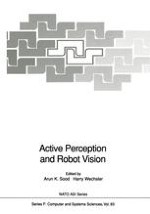1992 | OriginalPaper | Chapter
Group-Theoretic Approach to Motion Analysis for 3D Robotic Tracking
Author : Roy Eagleson
Published in: Active Perception and Robot Vision
Publisher: Springer Berlin Heidelberg
Included in: Professional Book Archive
Activate our intelligent search to find suitable subject content or patents.
Select sections of text to find matching patents with Artificial Intelligence. powered by
Select sections of text to find additional relevant content using AI-assisted search. powered by
“Motion Understanding” in the field of Computer Vision requires that sequences of 2D images be analysed for changes that result from the relative 3D motions of objects with respect to the observer. Many approaches to motion understanding in computer vision are based first on computing the ‘optical flow’ of a set of time-varying images. Traditionally, this vector field corresponds to the 2D translations of local regions of the intensity profile which shift as a result of the 3D motions in the visible world. However; there are higherorder transformations which occur in the image as a result of the projective geometry.It is proposed that, for the task of 3D visuo-motor tracking, local image-based transformations of moving object surfaces can be modelled by a six-parameter affine group. The six degrees-of-freedom of the Euclidean rigid-body motion group [Given by the semi-direct product of 3D translations and rotations, (cf. Carlton and Shepard[9]), E+= ℝ3 Ⓢ(3)] project perspectively to a unique six-dimensional vector field group, (cf. Blicher and Omohundro[6]). Six velocity-sensitive operator types are presented which estimate the one-parameter groups that decompose the local affine transformations in the moving scenes. The subgroups form a canonical basis for estimating 3D relative motion and surface orientation, as specified by the state of a quaternion.
